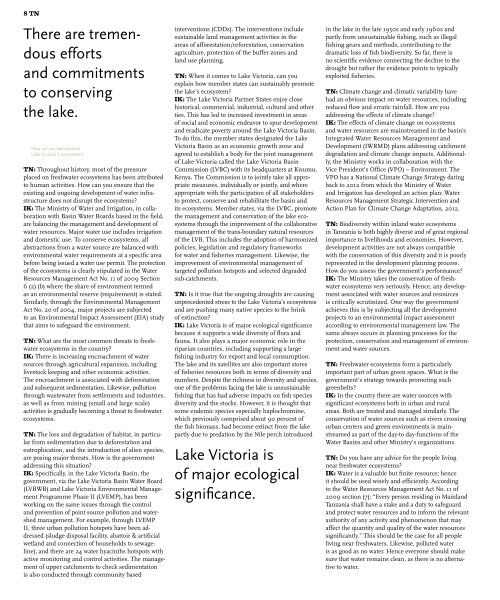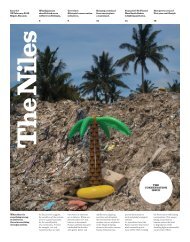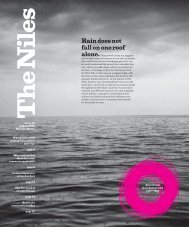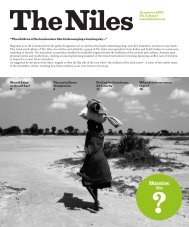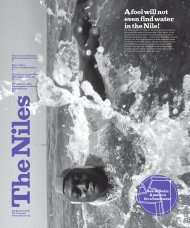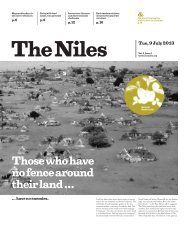You think of water when the well is empty...
Although we strive to be prepared, sometimes we can be caught unawares. That is why it’s worth thinking about water before the well goes dry in order to have enough time to plan ahead. Part of this preparation is knowing what the right questions are and striving to answer them. To be prepared and plan ahead also means to notice small changes when they occur. This can only happen if you spend time observing and learning. The Nile shows us its many facets depending on the light, the time of day and the mood of the observer. Noticing these changes helps us to know more and be prepared. Through the pages of this paper, correspondents from the Nile Basin countries share their experiences and observations about the Nile and try to find answers to the most relevant questions about the river. We celebrate the day of the Nile by thinking about water, before the well goes dry.
Although we strive to be prepared, sometimes we can be caught unawares. That is why it’s worth thinking about water before the well goes dry in order to have enough time to plan ahead. Part of this preparation is knowing what the right questions are and striving to answer them.
To be prepared and plan ahead also means to notice small changes when they occur. This can only happen if you spend time observing and learning. The Nile shows us its many facets depending on the light, the time of day and the mood of the observer. Noticing these changes helps us to know more and be prepared.
Through the pages of this paper, correspondents from the Nile Basin countries share their experiences and observations about the Nile and try to find answers to the most relevant questions about the river. We celebrate the day of the Nile by thinking about water, before the well goes dry.
Create successful ePaper yourself
Turn your PDF publications into a flip-book with our unique Google optimized e-Paper software.
8 TN<br />
There are tremendous<br />
efforts<br />
and commitments<br />
to conserving<br />
<strong>the</strong> lake.<br />
How can we best protect<br />
Lake Victoria’s ecosystem?<br />
TN: Throughout h<strong>is</strong>tory, most <strong>of</strong> <strong>the</strong> pressure<br />
placed on fresh<strong>water</strong> ecosystems has been attributed<br />
to human activities. How can you ensure that <strong>the</strong><br />
ex<strong>is</strong>ting and ongoing development <strong>of</strong> <strong>water</strong> infrastructure<br />
does not d<strong>is</strong>rupt <strong>the</strong> ecosystems?<br />
IK: The Min<strong>is</strong>try <strong>of</strong> Water and Irrigation, in collaboration<br />
with Basin Water Boards based in <strong>the</strong> field,<br />
are balancing <strong>the</strong> management and development <strong>of</strong><br />
<strong>water</strong> resources. Major <strong>water</strong> use includes irrigation<br />
and domestic use. To conserve ecosystems, all<br />
abstractions from a <strong>water</strong> source are balanced with<br />
environmental <strong>water</strong> requirements at a specific area<br />
before being <strong>is</strong>sued a <strong>water</strong> use permit. The protection<br />
<strong>of</strong> <strong>the</strong> ecosystems <strong>is</strong> clearly stipulated in <strong>the</strong> Water<br />
Resources Management Act No. 11 <strong>of</strong> 2009 Section<br />
6 (2) (b) where <strong>the</strong> share <strong>of</strong> environment termed<br />
as an environmental reserve (requirement) <strong>is</strong> stated.<br />
Similarly, through <strong>the</strong> Environmental Management<br />
Act No. 20 <strong>of</strong> 2004, major projects are subjected<br />
to an Environmental Impact Assessment (EIA) study<br />
that aims to safeguard <strong>the</strong> environment.<br />
TN: What are <strong>the</strong> most common threats to fresh<strong>water</strong><br />
ecosystems in <strong>the</strong> country?<br />
IK: There <strong>is</strong> increasing encroachment <strong>of</strong> <strong>water</strong><br />
sources through agricultural expansion, including<br />
livestock keeping and o<strong>the</strong>r economic activities.<br />
The encroachment <strong>is</strong> associated with deforestation<br />
and subsequent sedimentation. Likew<strong>is</strong>e, pollution<br />
through waste<strong>water</strong> from settlements and industries,<br />
as <strong>well</strong> as from mining (small and large scale)<br />
activities <strong>is</strong> gradually becoming a threat to fresh<strong>water</strong><br />
ecosystems.<br />
TN: The loss and degradation <strong>of</strong> habitat, in particular<br />
from sedimentation due to deforestation and<br />
eutrophication, and <strong>the</strong> introduction <strong>of</strong> alien species,<br />
are posing major threats. How <strong>is</strong> <strong>the</strong> government<br />
addressing th<strong>is</strong> situation?<br />
IK: Specifically, in <strong>the</strong> Lake Victoria Basin, <strong>the</strong><br />
government, via <strong>the</strong> Lake Victoria Basin Water Board<br />
(LVBWB) and Lake Victoria Environmental Management<br />
Programme Phase II (LVEMP), has been<br />
working on <strong>the</strong> same <strong>is</strong>sues through <strong>the</strong> control<br />
and prevention <strong>of</strong> point source pollution and <strong>water</strong>shed<br />
management. For example, through LVEMP<br />
II, three urban pollution hotspots have been addressed<br />
(sludge d<strong>is</strong>posal facility, abattoir & artificial<br />
wetland and connection <strong>of</strong> households to sewageline),<br />
and <strong>the</strong>re are 24 <strong>water</strong> hyacinths hotspots with<br />
active monitoring and control activities. The management<br />
<strong>of</strong> upper catchments to check sedimentation<br />
<strong>is</strong> also conducted through community based<br />
interventions (CDDs). The interventions include<br />
sustainable land management activities in <strong>the</strong><br />
areas <strong>of</strong> afforestation/reforestation, conservation<br />
agriculture, protection <strong>of</strong> <strong>the</strong> buffer zones and<br />
land use planning.<br />
TN: When it comes to Lake Victoria, can you<br />
explain how member states can sustainably promote<br />
<strong>the</strong> lake’s ecosystem?<br />
IK: The Lake Victoria Partner States enjoy close<br />
h<strong>is</strong>torical, commercial, industrial, cultural and o<strong>the</strong>r<br />
ties. Th<strong>is</strong> has led to increased investment in areas<br />
<strong>of</strong> social and economic endeavor to spur development<br />
and eradicate poverty around <strong>the</strong> Lake Victoria Basin.<br />
To do th<strong>is</strong>, <strong>the</strong> member states designated <strong>the</strong> Lake<br />
Victoria Basin as an economic growth zone and<br />
agreed to establ<strong>is</strong>h a body for <strong>the</strong> joint management<br />
<strong>of</strong> Lake Victoria called <strong>the</strong> Lake Victoria Basin<br />
Comm<strong>is</strong>sion (LVBC) with its headquarters at K<strong>is</strong>umu,<br />
Kenya. The Comm<strong>is</strong>sion <strong>is</strong> to jointly take all appropriate<br />
measures, individually or jointly, and where<br />
appropriate with <strong>the</strong> participation <strong>of</strong> all stakeholders<br />
to protect, conserve and rehabilitate <strong>the</strong> basin and<br />
its ecosystems. Member states, via <strong>the</strong> LVBC, promote<br />
<strong>the</strong> management and conservation <strong>of</strong> <strong>the</strong> lake ecosystems<br />
through <strong>the</strong> improvement <strong>of</strong> <strong>the</strong> collaborative<br />
management <strong>of</strong> <strong>the</strong> trans-boundary natural resources<br />
<strong>of</strong> <strong>the</strong> LVB. Th<strong>is</strong> includes <strong>the</strong> adoption <strong>of</strong> harmonized<br />
policies, leg<strong>is</strong>lation and regulatory frameworks<br />
for <strong>water</strong> and f<strong>is</strong>heries management. Likew<strong>is</strong>e, <strong>the</strong><br />
improvement <strong>of</strong> environmental management <strong>of</strong><br />
targeted pollution hotspots and selected degraded<br />
sub-catchments.<br />
TN: Is it true that <strong>the</strong> ongoing droughts are causing<br />
unprecedented stress to <strong>the</strong> Lake Victoria’s ecosystems<br />
and are pushing many native species to <strong>the</strong> brink<br />
<strong>of</strong> extinction?<br />
IK: Lake Victoria <strong>is</strong> <strong>of</strong> major ecological significance<br />
because it supports a wide diversity <strong>of</strong> flora and<br />
fauna. It also plays a major economic role in <strong>the</strong><br />
riparian countries, including supporting a large<br />
f<strong>is</strong>hing industry for export and local consumption.<br />
The lake and its satellites are also important stores<br />
<strong>of</strong> f<strong>is</strong>heries resources both in terms <strong>of</strong> diversity and<br />
numbers. Despite <strong>the</strong> richness in diversity and species,<br />
one <strong>of</strong> <strong>the</strong> problems facing <strong>the</strong> lake <strong>is</strong> unsustainable<br />
f<strong>is</strong>hing that has had adverse impacts on f<strong>is</strong>h species<br />
diversity and <strong>the</strong> stocks. However, it <strong>is</strong> thought that<br />
some endemic species especially haplochromine,<br />
which previously compr<strong>is</strong>ed about 90 percent <strong>of</strong><br />
<strong>the</strong> f<strong>is</strong>h biomass, had become extinct from <strong>the</strong> lake<br />
partly due to predation by <strong>the</strong> Nile perch introduced<br />
Lake Victoria <strong>is</strong><br />
<strong>of</strong> major ecological<br />
significance.<br />
in <strong>the</strong> lake in <strong>the</strong> late 1950s and early 1960s and<br />
partly from unsustainable f<strong>is</strong>hing, such as illegal<br />
f<strong>is</strong>hing gears and methods, contributing to <strong>the</strong><br />
dramatic loss <strong>of</strong> f<strong>is</strong>h biodiversity. So far, <strong>the</strong>re <strong>is</strong><br />
no scientific evidence connecting <strong>the</strong> decline to <strong>the</strong><br />
drought but ra<strong>the</strong>r <strong>the</strong> evidence points to typically<br />
exploited f<strong>is</strong>heries.<br />
TN: Climate change and climatic variability have<br />
had an obvious impact on <strong>water</strong> resources, including<br />
reduced flow and erratic rainfall. How are you<br />
addressing <strong>the</strong> effects <strong>of</strong> climate change?<br />
IK: The effects <strong>of</strong> climate change on ecosystems<br />
and <strong>water</strong> resources are mainstreamed in <strong>the</strong> basin’s<br />
Integrated Water Resources Management and<br />
Development (IWRMD) plans addressing catchment<br />
degradation and climate change impacts. Additionally,<br />
<strong>the</strong> Min<strong>is</strong>try works in collaboration with <strong>the</strong><br />
Vice President’s Office (VPO) – Environment. The<br />
VPO has a National Climate Change Strategy dating<br />
back to 2012 from which <strong>the</strong> Min<strong>is</strong>try <strong>of</strong> Water<br />
and Irrigation has developed an action plan: Water<br />
Resources Management Strategic Intervention and<br />
Action Plan for Climate Change Adaptation, 2012.<br />
TN: Biodiversity within inland <strong>water</strong> ecosystems<br />
in Tanzania <strong>is</strong> both highly diverse and <strong>of</strong> great regional<br />
importance to livelihoods and economies. However,<br />
development activities are not always compatible<br />
with <strong>the</strong> conservation <strong>of</strong> th<strong>is</strong> diversity and it <strong>is</strong> poorly<br />
represented in <strong>the</strong> development planning process.<br />
How do you assess <strong>the</strong> government’s performance?<br />
IK: The Min<strong>is</strong>try takes <strong>the</strong> conservation <strong>of</strong> fresh<strong>water</strong><br />
ecosystems very seriously. Hence, any development<br />
associated with <strong>water</strong> sources and resources<br />
<strong>is</strong> critically scrutinized. One way <strong>the</strong> government<br />
achieves th<strong>is</strong> <strong>is</strong> by subjecting all <strong>the</strong> development<br />
projects to an environmental impact assessment<br />
according to environmental management law. The<br />
same always occurs in planning processes for <strong>the</strong><br />
protection, conservation and management <strong>of</strong> environment<br />
and <strong>water</strong> sources.<br />
TN: Fresh<strong>water</strong> ecosystems form a particularly<br />
important part <strong>of</strong> urban green spaces. What <strong>is</strong> <strong>the</strong><br />
government’s strategy towards promoting such<br />
greenbelts?<br />
IK: In <strong>the</strong> country <strong>the</strong>re are <strong>water</strong> sources with<br />
significant ecosystems both in urban and rural<br />
areas. Both are treated and managed similarly. The<br />
conservation <strong>of</strong> <strong>water</strong> sources such as rivers crossing<br />
urban centers and green environments <strong>is</strong> mainstreamed<br />
as part <strong>of</strong> <strong>the</strong> day-to day-functions <strong>of</strong> <strong>the</strong><br />
Water Basins and o<strong>the</strong>r Min<strong>is</strong>try’s organizations.<br />
TN: Do you have any advice for <strong>the</strong> people living<br />
near fresh<strong>water</strong> ecosystems?<br />
IK: Water <strong>is</strong> a valuable but finite resource; hence<br />
it should be used w<strong>is</strong>ely and efficiently. According<br />
to <strong>the</strong> Water Resources Management Act No. 11 <strong>of</strong><br />
2009 section (7): “Every person residing in Mainland<br />
Tanzania shall have a stake and a duty to safeguard<br />
and protect <strong>water</strong> resources and to inform <strong>the</strong> relevant<br />
authority <strong>of</strong> any activity and phenomenon that may<br />
affect <strong>the</strong> quantity and quality <strong>of</strong> <strong>the</strong> <strong>water</strong> resources<br />
significantly.” Th<strong>is</strong> should be <strong>the</strong> case for all people<br />
living near fresh<strong>water</strong>s. Likew<strong>is</strong>e, polluted <strong>water</strong><br />
<strong>is</strong> as good as no <strong>water</strong>. Hence everyone should make<br />
sure that <strong>water</strong> remains clean, as <strong>the</strong>re <strong>is</strong> no alternative<br />
to <strong>water</strong>.<br />
10 AM, Ambo, Ethiopia.<br />
Checking bottles <strong>of</strong> mineral-rich<br />
sparkling <strong>water</strong> made in th<strong>is</strong> factory<br />
establ<strong>is</strong>hed 80 years ago in Sekele<br />
locality near a hot spring 130<br />
kilometres west <strong>of</strong> Add<strong>is</strong> Ababa.<br />
Getty Images News /<br />
Per-Anders Pettersson<br />
10AM


